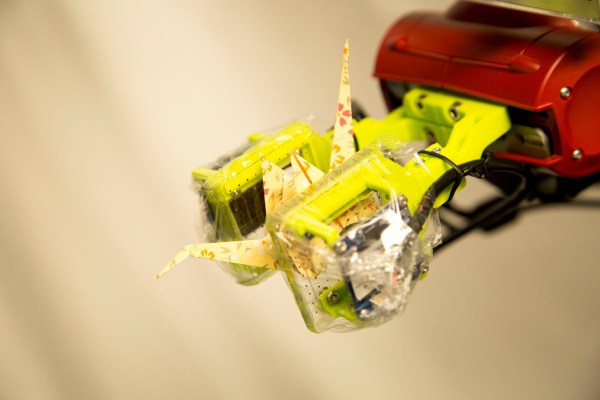Fingervision isn’t much to look at. At first glance, it appears as though someone MacGyvered a GoPro case out of some clear food wrap and bits of plastic, attaching the creation to the end of a $25,000 industrial robot — and honestly, that’s not all that far from the truth. The system is cheap by design, making what it can do all the more remarkable. Using a jury-rigged combination of off-the-shelf parts, the Carnegie Mellon-designed setup is able to give robots a rough approximation of a sense of touch.
Post-doctoral robotics fellow Akihiko Yamaguchi has posted a series of videos featuring a Baxter industrial robot performing a wide variety of impressive tasks with the Fingervision system mounted on the end of each arm. The industrial robot (somewhat awkwardly) peels a banana in one, and, in another, it responds to the light grazing of a feather, moving each time it’s grazed by the pink fuzz.
When we arrive at the CMU labs, Yamaguchi demonstrates the system’s soft touch further as Baxter’s hand closes gingerly on a flower and lifts it out of a Corona bottle (college!) and later picks up a small, fragile origami box from the table in front of it.
The system, outlined in a paper published late last year, features a pair of 3D-printed robotic grippers covered in clear silicone wrap decorated with black spots. There’s a small, $50 camera inside — as Yamaguchi notes, the prevalence of smartphone cameras has driven the size and cost of such technologies down considerably in recent years. The camera’s vision system tracks the movement of the black dots as they’re distorted when an object comes into contact with the robot’s cheap, transparent skin.

It’s a simple solution to a complex problem. Using Fingervision, the 300-pound robot can interact with fragile objects and detect when something it’s holding is slipping, tightening its grip to hang on. The team is hoping to extend the skin beyond the robot’s hands for future iterations.
“We want to cover the whole body with this kind of sensor, so the price is very important,” explains Yamaguchi, adding that more sensitivity could help the big industrial robot interact more safely with humans in a work setting.
[gallery ids="1511532,1511533,1511534,1511535,1511536,1511537,1511538"]
CMU plans to eventually open-source its Fingervision plans, so you might someday be able to bring tactile feedback to that robot you’ve been building in the basement.
